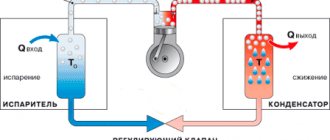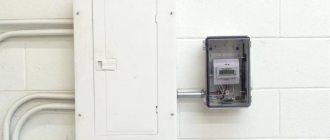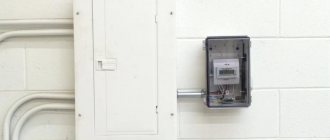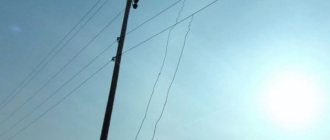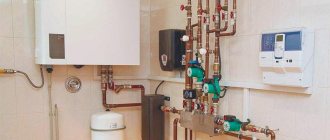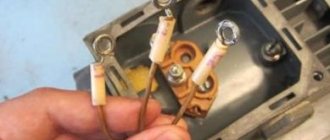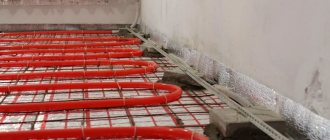Without exception, all household appliances are designed for certain power parameters. As a rule, the operating voltage range ranges from 190V to 240V. If the parameters of the incoming current comply with the established limits, then the manufacturer guarantees stable operation of its products. Unfortunately, due to the deplorable state of domestic power grids, voltage fluctuations are so high that deviations from permissible limits can be 20-30V, and in some cases even 50V. In such conditions, it is impossible to guarantee not only the normal operation of household electrical appliances, but also to safely divide the intended service life by at least half.
There are many ways to solve the problem of voltage drops: install special sensors that turn off the lights when there is a sharp change in the parameters of the incoming electricity, get the utility services, along with dozens of other residents of your block, to overhaul the power supply lines. However, in our opinion, the most convenient and simplest way to protect home appliances is to install a voltage stabilizer - a device that automatically adjusts the parameters of incoming electricity to generally accepted standards.
The problem of choosing a stabilizer model
Having decided to purchase voltage stabilizing equipment, you will probably be faced with the problem of choosing a model that meets the technical characteristics of the needs of your home. The abundance of offers on the market only aggravates the problem of choice, because devices of one type have the same advantages and disadvantages, while stabilizers with a different operating principle can boast of other advantages. To figure out which stabilizer to choose, seven-storage, electromechanical or relay, it is enough to identify priorities for yourself and, on this basis, give preference to certain features of each design.
The problem of choosing between single-phase and three-phase stabilizers stands apart. You can’t do without basic electrical knowledge here. Of course, you can call an electrician who will look into the electrical panel and share his recommendations. However, this is extra money and time that not everyone wants to spend. On the other hand, you can study the material in this article, remembering at the same time your school physics course, and subsequently independently choose the appropriate type of stabilizer.
QUATTRO ELEMENTI Stabilia 1000 W-Slim – interior solution
Voltage stabilizer in an ultra-thin case. Made in a wall mounting option. Used to work with household electrical appliances and electronic equipment. Protects elements of heating or water heating systems from power surges.
A microprocessor control system for the stabilization process is used. It has stable output parameters and does not distort the sinusoid. There is a soft start mode, protection against overheating and short circuit.
Pros:
- Compact, stylish design. Looks good on the wall.
- Build quality, visual reflection of output parameters on a digital display.
- It does not make noise, there are quiet clicks during power surges.
Minuses:
- Work only in indoor dry rooms; it is problematic to use it for a summer house.
Is it possible to use single-phase stabilizers for three-phase networks?
Of course you can! Let's say even more, in many houses a system of several single-phase stabilizers is installed instead of one three-phase one. There are many supporters and opponents of this approach to protecting home appliances from voltage surges. We will try to consider all the advantages and disadvantages of both methods.
By choosing the traditional three-phase network protection option, you will have the following advantages:
- a single housing and, as a result, connection of all supply lines to one block (three phases and zero);
- the device will display the total power of the three phases, and not separately, as it would be when connecting three single-phase units;
- the stabilizer display panel will display linear voltage if this function is provided for by the device design;
- simplicity and convenience of switching;
- increased reliability under heavy loads;
- greater power compared to the total performance of single-phase analogues.
Possible disadvantages:
- most three-phase models cost an order of magnitude more than the total cost of three single-phase stabilizers;
- Some models of three-phase stabilizers may stop working when one of the phases is disconnected.
When choosing three single-phase stabilizers, the buyer receives the following advantages:
- There are many models on the market with the ability to mount on a wall, which cannot be said about three-phase analogues;
- when one of the phases is turned off, the others continue to work, due to which sudden power outages will occur much less frequently;
- the owner of three single-phase stabilizers gets the opportunity to regulate each phase separately, which three-phase equipment does not allow;
- oddly enough, but buying three single-phase devices will cost you less than one three-phase one;
- The smaller dimensions and weight of each stabilizer mean more convenient transportation and installation in the home.
Key disadvantages:
- low power compared to three-phase stabilizers;
- lack of a single information panel that would display the parameters of incoming and outgoing electricity.
As you probably already understood, each of the approaches has a number of distinctive advantages and downright weaknesses. Therefore, when choosing an electricity stabilization system, it is worth starting from your personal needs and the characteristics of the internal electrical network. Unfortunately, many buyers often prefer a system consisting of three single-phase devices due to its low cost. As practice shows, half of them later regret it, since the choice did not take into account key needs, such as total power or displaying information about the characteristics of incoming electricity.
Addition: stabilizers suitable for a private home
I tried to select only the best models of stabilizers that are guaranteed to be suitable for a private home.
Energy Voltron PCH-10000
Relay, single-phase Power - 10 kVA (or 7 kW) Operating range - 105...265 V Stabilization accuracy - 10% (198...242 V) Voltage indicators available Built-in protection, noise filter Bypass function Wall/floor installation (universal) Built-in cooling fan Heavy Expensive
Stabilizer Energy Voltron RSN-10000 is a single-phase 7-kilowatt relay stabilizer with 7 stages of stabilization, thanks to which it operates over a wide range of input voltages - from 105 to 265 volts. The output voltage is maintained within 198…242 V, that is, in full compliance with GOST. Simply a wonderful voltage stabilizer for a country house.
The noise level corresponds to the norm for residential premises from 23:00 to 7:00 (no more than 30 dB). I feel like the noise produced by the stabilizer is no louder than the ticking of a wall clock, but it’s still not worth putting it in the bedroom.
There are two voltmeters on the front panel, simultaneously indicating the input and output voltage. A wide temperature range from -30 to +40°C allows the use of the stabilizer in the winter when the house is not heated.
The stabilizer has a built-in surge filter, a start delay after shutdown, protection against overvoltage and overheating. Like all powerful stabilizers, it has a significant weight (about 20 kg) and is designed for permanent installation - mounted on a wall or placed on a shelf or floor. All connections to wires are made using terminals, which adds solidity. The “Bypass” mode allows, if necessary, to exclude the stabilizer from the power supply circuit.
I know firsthand the story of one copy of the Voltron PCH-10000, which was bought just for a country house. An air conditioner, refrigerator, TV and even a kettle are connected to it. For almost five full years there have never been any problems.
RUCELF SRWII-12000-L
Relay, single-phase Power - 12 kVA (or 10 kW) Operating range - 110...270 V Short-term endurance - 95...280 Stabilization accuracy - 8% (202...238 V) Operating temperature - from 0 to 40°C There are voltage and temperature indicators Built-in protection, noise filter Bypass function Wall installation only Natural cooling Weight 22.5 kg High quality, expensive
Powerful relay stabilizer for as much as 10 kilowatts. Due to the 6-step output voltage adjustment, the RUCELF SRWII-12000-L voltage stabilizer works great in a very wide range of input voltages (from 95 to 280 volts in extreme mode). The front panel has an LCD indicator that simultaneously shows the input and output voltage, as well as the temperature inside the stabilizer and the output power scale.
There are no built-in fans, cooling is carried out by natural convection, so for normal operation it needs to be mounted on a wall. Putting it somewhere on the floor and sticking it in a corner will not work - it will overheat and shut down. But this also has its advantage: since there are no fans, this means there is no unnecessary noise during operation. And wall mounting, in my opinion, is much more rational and saves space in the house.
In general, the box is of course hefty and heavy, inspiring a feeling of confidence and reliability. A little expensive, but buy it and forget it. This power is more than enough for any country cottage or summer house.
When the relay switches, you hear clicks and notice how the brightness of the light bulbs changes. But this is a problem in general with all stabilizers with step adjustment (relay and electronic). If you are annoyed by jumps in brightness, I can advise you to power all the lighting separately from a small electromechanical one or, better yet, from a double conversion stabilizer.
Of course, the Ruself 12000 voltage stabilizer has all possible protection systems (overheating, overvoltage, power overload, short circuit), a “Bypass” button, and protects equipment from RF interference. The case, by the way, is metal and does not support combustion - a significant plus for safety.
Here is a video report on the operation of this stabilizer a year after the start of operation:
Unfortunately, use is only allowed in heated rooms with low humidity. If you have a house, for example, in the Leningrad region, where air humidity is usually above 90%, this model is absolutely not suitable for you. But for residents of all other regions - an excellent stabilizer for a private home!
SVEN AVR PRO LCD 5000
Relay, single-phase Power - 5 kVA (or 4 kW) Operating range - 140...260 V Stabilization accuracy - 8% (202...238 V) Voltage indicators available Built-in protection, noise filter No Bypass function Installation only wall-mounted Cooling is forced Weight 10.5 kg Inexpensive
The SVEN AVR PRO LCD 5000 voltage stabilizer is an excellent, but at the same time inexpensive (less than 7 thousand rubles) relay stabilizer for a cottage or small private house. The design is simple, there is nothing special to break there. Even when operating at full power, the transformer heats up to no more than 50°C. The circuit uses 4 relays with a rated switching current of 30 A, i.e. with almost half the safety margin.
The stabilizer protects it from overheating, too high voltage and short circuit in the load. There is a switch-on delay after an emergency shutdown (using the red button you can choose what suits you best - 5 seconds or 3 minutes). There is only one digital voltmeter, so it shows the input and output voltage alternately.
The build quality is not bad, the case is stamped from thick steel, and powerful terminals are provided for connecting wires. In general, SVEN AVR PRO LCD 5000 leaves only pleasant impressions. The only pity is that now it is becoming more and more difficult to find it on sale.
By the way, if this model is slightly less powerful, pay attention to its older brother - SVEN AVR PRO LCD 8000. Its power is already 6400 watts, and the quality is at the same decent level.
RESANTA SPN-13500
As for the Resant stabilizers, I have never liked them. And in order not to change traditions, I’ll scold their new model a little.
Oddly enough, a very popular stabilizer. Relay, single-phase, with all required protections and a declared 13.5 kilowatts of power.
It looks good from the outside, but the inside is pure handicraft. The assembly was careless, we saved on everything we could: on copper wires (we wound aluminum ones), on cambrics, on terminals. But they plugged in as many as 5 pieces for 80 Amps.
The Resanta SPN-13500 stabilizer is one of the few models where the manufacturer made an obvious lie and greatly inflated the output power and, accordingly, the cost. In fact, its power does not exceed 7000 W with an input voltage above 190 volts. By the way, there can be no talk of any 4800 watts at 90 volts (although this is exactly what is stated on the case).
Although, it cannot be said that the stabilizer is completely worthless. It works (really works!) in a wide range and even at 90V, which in itself is worthy of respect. If you can find it for reasonable money and connect no more than 3-5 kW to it, then you can use it. But personally, I would not recommend such a stabilizer for a country house.
This video will help you evaluate the quality of Resanta:
Features of calculating the required stabilizer power
As we said above, when choosing between a three-phase device or several single-phase ones, an important role is played by the load consumed by household appliances and other consumers of electricity. As a rule, voltage stabilizers are installed either to protect individual equipment or to ensure stable voltage throughout the entire in-house electrical network. In the first case, the total power most likely will not be high enough that a trio of single-phase devices cannot handle it. If you plan to connect the entire house to the stabilizer, then in such a situation you need to approach the power calculation with great care, since the total load may be unexpectedly large.
First, write a list of all the electrical appliances that you plug into the network from time to time. Then you need to find out the power of each of the devices being recorded. This information can be gleaned from equipment passports or looked at on the back tag, where the operating voltage, current frequency and power consumption are usually indicated.
In the process of calculating the total power, it is necessary to take into account the fact that you need to operate with the so-called total power - a parameter that consists of active and reactive powers. As a rule, the parameter in the passport, which is indicated in Watts, represents the active power of the device. The total power can be calculated using the volt-ampere parameter. Let us consider in more detail what the active and reactive components of the load are.
A resistive load occurs in the process of converting electricity into other types of energy, for example, light, kinetic, thermal. For most modern devices, this type of load is the main one, which is why it is indicated not only in the passport, but also on the back wall.
Reactive load includes all other types of loads, which in turn are divided into two types: capacitive and inductive. So, for example, the total power of devices that contain one or more electric motors is related to the active power by the coefficient cos φ. Often, the manufacturer indicates, in addition to the active load, which is designated by Watts, the cos φ coefficient. If you have re-read all the pages of the passport, but still have not found information about the coefficient, use the default parameter cos φ=0.7 for calculations. The total power in this case is calculated by dividing the active load by the above coefficient. For example, if you purchased a vacuum cleaner with a power of 1800 W, and its passport indicates the coefficient cos φ = 0.6, then the total power will be 3000 W.
Pulse transformer stabilizers
The electrical circuit of the stabilizer on a pulse-type transformer is similar to that of a relay device. But there are some differences. The main component here is the modulator. It reads the voltage value, then the signal goes to the transformer, where the information is processed.
To change the current value, two converters are used. But some samples have only one converter. The rectifier divider is put into operation to cope with the electromagnetic field. As the voltage increases, it decreases the highest frequency. To supply current to the winding, the diodes send a signal to the transistors. The equalized output voltage flows through the secondary winding.
Voltage stabilizer power and consideration of high inrush currents
You probably remember from your school physics course that at the moment of starting, each electric motor consumes an order of magnitude more energy compared to its rated power. Therefore, if the design of household appliances includes one or more electric motors, the starting loads are correspondingly two or three times higher than the power indicated in the passport. When accounting for such electrical appliances, experts recommend multiplying the parameters specified in the passport by three times. This recalculation will allow you to avoid rebooting the stabilizer when you turn on powerful electrical appliances containing an electric motor.
Having calculated the total power of all household appliances, add +20% to this value. This will not only ensure gentle operation of your stabilizer, but also create a certain reserve for connecting additional equipment in the future.
conclusions
You should choose a stabilizer for a private home taking into account the quality of the electrical network, the total power and the nature of the load of the devices connected to it. For an average house, not very stuffed with equipment, a stabilizer with a power of 5-10 kW will be enough. If the house only has a refrigerator, a TV (although a stabilizer is not needed for TV at all) and a couple of light bulbs, then 3 kW will be enough, there is no point in overpaying.
Sometimes it is advisable to install in a private house not one high-power stabilizer for all consumers, but two or more of lower power, each for its own section of the network or for its own group of consumers. It is also possible to connect individual electrical appliances through their own individual stabilizer, but this is if there is nowhere to put the money.
When the voltage in the network is constantly under or overestimated, electromechanical models are well suited. For frequent voltage surges, it is better to choose a relay or electronic (thyristor/triac) stabilizer. It is advisable to buy inverter models only to protect very expensive and capricious appliances that are difficult to imagine in a country house.
Stabilization accuracy
One of the most important parameters that are taken into account when choosing voltage stabilizers is the accuracy of adjustment of current parameters. To operate with specific values, carefully study the operating voltage range in the data sheets for your household appliances. This way you can calculate the maximum voltage fluctuation range allowed by home appliance manufacturers.
In most cases, stabilizers with high precision voltage correction are used only to ensure stable operation of high-precision industrial machines of medical equipment and other devices that are highly sensitive to changes. For domestic needs, devices with an adjustment accuracy of 5-7% are usually used. Their capabilities are quite enough to ensure that household appliances work without failures.
The best electronic stabilizers 220V
The 220 volt digital voltage stabilizer is based on the activation of an electronic key when significant deviations occur in the electrical network. Features fast response time.
It has smaller overall dimensions and weight. The device can operate at negative temperatures. Selection criteria: power of connected consumers, response time, error.
Calm R 400ST – electronics protection
Triac single-phase stabilizer for correcting unstable parameters of the electrical network. Designed to protect electronic control units of heating equipment, computers or office equipment.
Elimination of extraneous frequency noise in input and output currents is provided; it does not distort the sinusoid. Possesses high-speed response in case of emergency power supply situations.
Pros:
- Raises voltage from 150 volts, automatic shutdown at extreme values.
- Protects the boiler well. I bought a second stabilizer for my computer.
- Fast, quiet, does not bother you at peak loads.
Minuses:
- Pricey, but the features justify the cost.
Energy 12000 VA Classic E0101-0099 – reliability of stabilization
A modern electronic device for stabilizing single-phase voltage 220 volts. It has a fast response time, not exceeding 20 milliseconds. The protection range is 60~265 volts, accuracy 125~254V.
The device confidently rectifies current at external temperatures of -30 - +40°C. The percentage of error does not exceed 5 units. Built-in display for visualizing output parameters. Motor life exceeds 60,000 hours of continuous operation.
Pros:
- Reliability, stability, accuracy.
- Power, frost resistance, can be installed in auxiliary rooms.
- High motor potential.
Minuses:
- The wall mounting scheme has not been thought through. There are no handles for carrying, and this is due to its weight.
Calm R 10000 – informative
Thyristor stabilizer single-phase voltage 220 volts. It is used for reliable protection of equipment in medical institutions, computer and office equipment, and high-precision instruments in scientific and research laboratories from instability of the electrical network.
Works effectively with various household appliances. Double protection is provided for peak current values in the electrical network. The case is made in a floor-standing design.
Pros:
- Stability of operation, service life.
- Precise adjustment, informative indication, display.
- Efficient cooling.
Minuses:
- It's heavy and there are no handles or features for transportation.
Volt engineering Ampere-T E 16-1/80 v2.0 – accuracy
Single-phase stabilizer with highly reliable transformer control of thyristor switches. It is distinguished by its speed of action and high accuracy of rectified parameters. An electronic bypass is provided to bypass the stabilization system.
The straightening process is controlled by a microprocessor unit. Extended and detailed information about the current state of the device is displayed on the outer case.
Pros:
- High power, stable operation, precision.
- Visual control panel, wide information content.
- Possibility of working in conjunction with a generator.
Minuses:
- Difficulty hanging on the wall.
Review of brands of household stabilizers
ORTEA
The Italian company, since 1969, has been one of the world leaders in the production of voltage stabilizers. The company has offices in all major countries of the world. In Russia, ORTEA is represented by 700 offices in different cities. The company's product line includes single-phase stabilizers of the GEMINI
(20 kVA),
VEGA
(up to 25 kVA),
ANTARES
(up to 135 kVA) and three-phase
AQARIUS
(up to 60 kVA),
ORION
(up to 250 kVA),
ORION Plus
(up to 1250 kVA) and the unique
SIRUS New
with a power of up to 6000 kVA . The company's stabilizers can operate at low temperatures. All models come with a 2-year warranty and 3 years of free service.
One of the company’s popular models is ORTEA VEGA 1
. Single-phase electrodynamic voltage stabilizer with an input range from 176 to 253 V. Regulation time 16 ms/V, load power 1 kVA. Dimensions of the device are 280x430x260 mm, weight 16 kg. Price - 37,944 rubles.
"Bastion"
The Russian company produces more than 300 serial products, including voltage stabilizers. A distinctive feature of the company is the presence of its own design bureau, which allows the entire production cycle to be carried out, from development to production. The company has 68 patents and copyright certificates for its own products. In Russia there are 6 branded stores and 56 service stores that produce Teplocom
and
Skat
. Some devices come with a lifetime warranty.
Relay stabilizer "Bastion" Teplocom ST
— 555 has a power of 0.555 kW, input voltage range 145–260 V, regulation time up to 20 ms, dimensions 130x70x85, weight 1.8 kg. Price - 3700 rubles. This stabilizer is suitable for protecting a gas boiler in a private house or cottage.
"RESANTA" (manufactured in China)
According to the Internet agency MegaResearch, in 2014–2015. was a leader in the market of welding equipment and voltage stabilizers. The company's service centers are located in all major cities of the country. The company's product range includes single-phase digital and electromechanical stabilizers of the ASN series, low-voltage stabilizers SPI, household single-phase C series and three-phase ASN series of various capacities.
Relay stabilizer "Resanta" ASN - 2000 N/1-Ts Lux has a power of 1 kVA, input voltage range 140-260 V. Regulation time up to 7 ms/V, dimensions 206x133x230, weight 4 kg. Price - 3500 rubles.
Electrical parameters
Each type of diode has its own operating and maximum permissible parameters, according to which they are selected for operation in a particular circuit:
- Irev – constant reverse current, µA;
- Upr – constant forward voltage, V;
- Ipr max – maximum permissible forward current, A;
- Urev max – maximum permissible reverse voltage, V;
- Р max – maximum permissible power dissipated by the diode;
- Operating frequency, kHz;
- Operating temperature, C.
Not all diode parameters are given here, but, as a rule, if you need to find a replacement, then these parameters are sufficient.
Circuit of a simple AC rectifier using one diode
We will apply AC mains voltage to the input of the rectifier, in which positive half-cycles are highlighted in red and negative half-cycles are highlighted in blue. We will connect a load (Rн) to the output of the rectifier, and a diode (VD) will perform the function of the rectifying element. With positive half-cycles of voltage applied to the anode of the diode, the diode opens.
At these moments of time, a forward diode current Ipr flows through the diode, and therefore through the load (Rн), powered by the rectifier (the half-cycle wave is shown in red in the right graph). With negative half-cycles of voltage supplied to the anode of the diode, the diode closes, and a slight reverse diode current (Irev) will flow throughout the entire circuit. Here, the diode seems to cut off the negative half-wave of the alternating current (in the right graph, such a half-wave is shown by a blue dotted line).
As a result, it turns out that through the load (Rн), connected to the network through a diode (VD), it is no longer alternating current, since this current flows only in positive half-cycles, and the pulsating current is a current of one direction. This is AC rectification. But this voltage can only power a low-power load that is powered by an AC mains and does not have any special power requirements, for example, an incandescent lamp.
Voltage will only pass through the lamp during positive half-waves (pulses), so the lamp will flicker faintly at a frequency of 50 Hz. However, due to thermal inertia, the filament will not have time to cool down in the intervals between pulses, and therefore the flickering will be faintly noticeable. If we power a receiver or power amplifier with this voltage, then in the loudspeaker or speakers we will hear a low-pitched hum with a frequency of 50 Hz, called AC hum. This will happen because the pulsating current, passing through the load, creates a pulsating voltage in it, which is the source of the background.
This drawback can be partially eliminated if a high-capacity filtering electrolytic capacitor (Cf) is connected in parallel with the load. Charging with current pulses during positive half-cycles, the capacitor (Cf) during negative half-cycles is discharged through the load (Rн)
. If the capacitor is of sufficiently large capacity, then during the time between current pulses it will not have time to completely discharge, which means that the load (Rн) will continuously maintain current both during positive and negative half-cycles. The current maintained by charging the capacitor is shown in the right graph as a solid wavy red line.
Power rectifier diode But even with such a somewhat smoothed current, it is also impossible to power a receiver or amplifier because they will “phon”, since the level of pulsation (Upulse) is still very noticeable. In the rectifier, the operation of which we have become acquainted with, the energy of only half of the alternating current waves is usefully used, therefore more than half of the input voltage is lost on it and therefore such rectification of alternating current is called half-wave, and rectifiers are called half-wave rectifiers. These shortcomings are eliminated in rectifiers using a diode bridge.
Manufacturer selection and prices
The most difficult thing is to choose a manufacturer. Staz should say that it is better not to consider Chinese units. Even with those that are only half Chinese (with production located in the Middle Kingdom and head office in another country), you need to be very careful. Quality is not always consistent.
Tips for choosing a stabilizer
If the external component is not important to you, pay attention to stabilizers made in Russia or Belarus. This is Calm and Leader. Quite decent units, with not a very good design, but with stable quality.
If you need the perfect equipment, look for Italian ORTEA. Their build quality and appearance are excellent. RESANT also has good reviews. Their product is rated 4-4.5 on a five-point scale.
The range of prices is amazing, but the types of equipment collected here are very different - from budget relay and electromechanical to super-reliable electronic.
Application of diodes
One should not think that diodes are used only as rectifiers and detectors. In addition, you can highlight many more of their professions. The current-voltage characteristics of diodes allow their use where nonlinear processing of analog signals is required. These are frequency converters, logarithmic amplifiers, detectors and other devices. Diodes in such devices are used either directly as a converter or form the characteristics of the device when included in the feedback circuit. Diodes are widely used in stabilized power supplies, as reference voltage sources (zener diodes), or as switching elements of storage inductors (pulse voltage stabilizers).
Rectifier diodes.
We recommend reading: Thyristors: principle of operation, testing and characteristics
Using diodes it is very easy to create signal limiters: two diodes connected back-to-back - in parallel serve as excellent protection for the input of an amplifier, for example, a microphone, from supplying an increased signal level. In addition to the listed devices, diodes are very often used in signal switches, as well as in logic devices. It is enough to recall the logical operations AND, OR and their combinations. One type of diode is LED. Once upon a time they were used only as indicators in various devices. Now they are everywhere, from the simplest flashlights to TVs with LED backlighting, it is simply impossible not to notice them.
For devices
I have selected inexpensive low-power stabilizers for this class, which are suitable for protecting an individual consumer - a refrigerator, TV or computer. For such stabilizers it is important: the power is not lower than that declared for the protected device, the maximum input voltage is not lower than 242 V (according to GOST voltage in the apartment).
Energy Hybrid SNVT 500 – from 2,700 rubles
Hybrid single-phase voltage stabilizer. Such stabilizers belong to the electromechanical subtype. Since the relay design is equipped with additional stabilizers - which distinguishes hybrid devices from electromechanical ones - high stabilization accuracy is achieved. Most often, for such devices it is in the range of 1.5-3%.
| Advantages | Flaws |
|
|
Bypass* is the ability to supply voltage without stabilization. It is convenient if the voltage in the network is stable for a long time - turn on the “Bypass” and save the service life of the stabilizer.
I recommend Hybrid SNVT to 500 people who are interested in protecting specific devices.
It has a wide input voltage range, high accuracy and low price - it is ideal for protecting any computer. Characteristics table of Hybrid SNVT 500
| Characteristic | Meaning |
| Active power | 0.5 kW |
| Input voltage range | 105-280 V |
| Accuracy | 3% |
| Working temperature | -5…+40 |
| Efficiency | 98% |
| Cooling | Natural |
| Execution | Floor |
Watch a video about the Energy SNVT Hybrid series:
Shtil InStab IS1500 - from 12,949 rubles
Inverter stabilizer designed to protect several electrical appliances at once. Thanks to the type of operation, the voltage is stabilized without delay, accurately and without any noise. The output voltage is not distorted and always maintains a sinusoidal shape.
| Advantages | Flaws |
|
|
The device has no mechanical elements; it is built on transistors and integrated components.
Therefore, high reliability and service life are ensured. Characteristics table Shtil InStab IS1500
| Characteristic | Meaning |
| Active power | 1.5 kW |
| Input voltage range | 165-310V at 100% load, 135-310V at 80% load, 90-310V at 60% load |
| Accuracy | 2% |
| Working temperature | -5…+40 |
| Efficiency | 97% |
| Cooling | Forced |
| Execution | Floor and wall |
Video review:
FAQ
How to calculate the power of the stabilizer I need?
Each electrical appliance must have a passport indicating its operating characteristics. If it is lost, you can always find it on the Internet. Add up all the power - you get an approximate value.
You can’t buy an end-to-end stabilizer - you’ll end up with almost the same thing that old TPs provide. Take a power reserve of 30-50% so that you can use other tools.
Speaking of tools, don't forget to consider the powerful tools you plan to use. The tool has large starting currents, a factor of 2-3. Therefore, if you plan to use powerful machines, feel free to take a stabilizer twice as powerful as the consumer one.
What is the difference between an IPB and a stabilizer?
The stabilizer works as long as voltage is present. An uninterruptible power supply is a battery that needs a network to recharge. They do not produce a pure sine wave, therefore they are inferior to stabilizers in the role of “protectors” of the house.
UPS - uninterruptible power supplies - are needed for emergency power supply. For example, gas boilers in case of a power outage. The UPS stores power in low-voltage batteries, and during a power outage, it supplies current with the required voltage. Not all UPSs produce a pure sine wave.
The stabilizer brings the mains electricity parameters back to normal and does not store energy.
Classification by purpose and device
AC generator
AC rectifiers are divided into several different types, depending on the characteristics, the use of alternating current periods, circuits, the number of phases and the type of transmitting element. In general, the classification is as follows:
- By the number of periods involved in the work (one- and two-half-wave, as well as with full and incomplete use of the wave);
- By type, devices are divided into those that include an electronic bridge, voltage multipliers, with or without transformers;
- Based on the number of phases, they are divided into single-phase, two-phase, three-phase and N-phase;
- According to the type of device that transmits a sine wave, they are divided into semiconductor diode and thyristor, mechanical and vacuum, mercury;
- Based on the type of transmitted waves, they are divided into pulsed, analog and digital.
